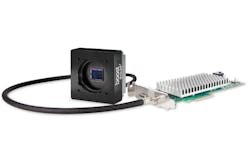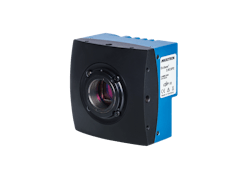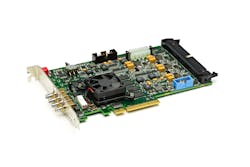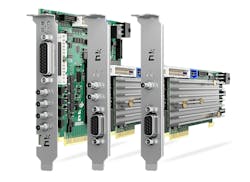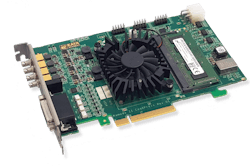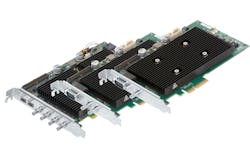While CoaXPress 2.0 products were introduced at VISION 2018 in Stuttgart, Germany, the standard became official in 2019. Version 2.0 offers an extension of the Japan Industrial Imaging Association’s (JIIA; Tokyo, Japan; www.jiia.org) CoaXPress standard, which was first introduced as a standard in 2011.
With CXP 2.0 comes new features, functionalities, and speed ranges above the previous limit of 6.25 Gbps (CXP-6) to speeds of 10 (CXP-10) and 12.5 Gbps (CXP-12). Unlike USB3, which relies on passive cable lengths of two meters or less, CoaXPress 2.0 also maintains the 100-meter maximum length coaxial cables without the need for repeaters which can negatively impact signal integrity.
Though CXP 2.0 extends to CXP-12, they are not synonymous, explains Mike Cyros, Vice President of Sales and Support, Americas, Euresys (Angleur, Belgium; www.euresys.com).
“While there is an association between CXP-12 and CXP 2.0, these should really be thought of as different items,” he says. “The new CoaXPress 2.0 specification includes several important new features and improvements which include new uniform time stamping, improved error reporting, data sharing, new speed ranges up to 12.5 Gbps, support for new HD-BNC connectors, as well as further electrical and mechanical improvements.”
Cyros adds, “The reason they should be thought of separately is that the new features and enhancements in the CXP 2.0 version of the standard applies to all CXP speeds, and not just new CXP-12 speeds made possible with CXP 2.0.”
CXP 2.0 benefits
In addition to higher speeds, a CXP 2.0 link with four CXP-12 connections supports a data transfer rate of up to 50 Gbps, which is sufficient to operate a 10-bit, 12 MPixel area scan sensor at more than 300 fps. The standard also increases the up-connection bitrate from host to device from 20.83 Mbps to 41.6 Mbps for CXP-10 and CXP-12. CXP 2.0 also supports Micro-BNC (or HD-BNC) connectors, which can handle the high frequency signals required at speeds of 12.5 Gbps.
CoaXPress 2.0 also offers Unified Time Stamping, allowing reporting events coming from devices, hosts, and software into a unified time reference. With this, host and device maintain an internal and independent free-running time clock, and both host and device will timestamp internal events with their respective time clocks: “t-dev” for device events and “t-host” for host events. A new communication path introduced in CoaXPress 2.0, the event channel, provides the device a mechanism to asynchronously send messages and status updates to a host. All event messages are timestamped using Unified Time Stamping, and the device can inform the application through the new channel when specific internal events occur.
Also introduced with CoaXPress 2.0 is a series of counters providing users with a clear view of the link quality during operation. These counters are incremented whenever a link-related problem occurs, and the error reporting application can read or reset these counters via GenApi. Another new feature in CoaXPress 2.0 defines rules for data sharing, where a device simultaneously streams data to more than one host. A data-sharing capable device must have more than one link and each link (or sub-device) must be a standard CoaXPress link.
CXP 2.0 cameras
Basler (Ahrensburg, Germany; www.baslerweb.com) offers four CXP 2.0 cameras in its boost series, including the boA4112-68cm (monochrome) and boA4112-68cm (color). Based on the 12.29 MPixel IMX253 Pregius CMOS sensor from Sony (Tokyo, Japan; www.sony.com), these cameras offer frame rates of up to 68 fps. The boA4096-93cm (monochrome) and boA4096-93cc (color) cameras feature Sony’s 8.85 MPixel IMX255 CMOS sensor and reach speeds of up to 93 fps. Both models feature a new Micro-BNC connector and the company’s Bundle package (Figure 1) offers a CXP-12 interface card. Customers can benefit from smooth integration of both components via one software development kit, even for complex applications, according to the company.
“With our boost series, the goal is to augment our existing offerings for applications such as medical, automation, and traffic with higher-speed CoaXPress 2.0 cameras,” says Thomas Karow, Product Market Manager, Basler. “For the future roadmap, I can’t give much away right now, but an expansion of this portfolio is certainly in the pipeline.”
Kaya Instruments (Nesher, Israel; www.kayainstruments.com) offers five models, each available in both color and monochrome cameras, in its Iron series: Iron CXP 305 (8.85 MPixel Sony IMX305 CMOS sensor, 62.5 fps), Iron CXP 255 (8.85 MPixel Sony IMX255 CMOS sensor, 87.6 fps), Iron CXP 253 (12.29 MPixel Sony IMX253 CMOS sensor, 68.3 fps), Iron CXP 252 (3.15 MPixel Sony IMX252 CMOS sensor, 205.8 fps), and the Iron CXP 250 (5.01 MPixel Sony IMX250 CMOS sensor, 155.5 fps). All models feature a Micro-BNC connector and optional MCX7 connector series.
“It was clear to us that CoaXPress and CoaXPress 2.0 in particular represent a big step forward in terms of performance, and Kaya Instruments believes in constantly looking toward the future with regards to such machine vision technologies,” says Michael Yampolsky, Founder and CEO, Kaya Instruments. “Going forward, the company plans to expand the line of CoaXPress 2.0 products, including a CoaXPress 12G range extender over fiber and a new series of compact, global shutter cameras featuring GPIXEL image sensors.”
For its part, Mikrotron (Unterschleissheim, Germany; www.mikrotron.de/en) offers two models, in its EoSens 1.1CXP2 and EoSens 2.0CXP2 cameras. Available in color and monochrome, the EoSens 1.1CXP2 camera features the 1.1 MPixel LUX13HS CMOS image sensor from Luxima Technology (Pasadena, CA, USA; www.luxima.com) and frame rates of 3,600 at full resolution, while the EoSens 2.0CXP2 (Figure 2) is based on the 2 MPixel LUX19HS CMOS image sensor and achieves 2,220 fps at full resolution and up to 170,000 fps at reduced resolution. Both models measure 80 x 80 x 53 mm and feature a Micro-BNC connector.
“With the 1.1CXP2 and 2.0CXP2 CXP12 cameras, Mikrotron expands its CXP camera portfolio and addresses applications such as 3D laser triangulation and laser target tracking, which require very high frame rates at reduced vertical region of interest,” says Stephen Ferrell, Director of Business Development, Americas, Mikrotron. “The 2.0CXP2 camera reaches 47,695 fps, a speed that enables increased inline resolution in various surface inspection applications.”
Offering four CXP 2.0 cameras each available in color and monochrome, Optronis (Kehl, Germany; www.optronis.com/en) offers the CamPerform-Cyclone series featuring Luxima Technology sensors. Cyclone-16-300-M/C cameras feature the 16 MPixel LUX160 CMOS sensor and reach 284 fps, while Cyclone-2-2000-M/C cameras feature the 2 MPixel LUX19HS CMOS sensor and reaches up to 2158 fps. The Cyclone-5-700-M/C cameras feature the 5 MPixel LUX51 CMOS image sensor and reach 705 fps, while the new Cyclone-1HS-3500-M/C cameras feature the 1 MPixel LUX13HS CMOS image sensor and achieve frame rates of up to 3518 fps. All camera models feature Micro-BNC connectors.
Providing flexibility for CoaXPress 2.0 cameras, the CoaXPress rotary joint from Saber1 Technologies (Lowell, MA, USA; www.saber1.com) allows full 360° rotation for up to six CXP-12 channels. The single-channel, copper alloy rotatory joint can rotate at a maximum speed of 60 rpm.
CXP 2.0 frame grabbers
Active Silicon (Iver, Buckinghamshire, UK; www.activesilicon.com), whose chief technology officer Chris Beynon is the Technical Chair of the CoaXPress standard, offers CoaXPress frame grabbers for image acquisition, including its FireBird Quad CXP-12 3PE8 and FireBird Quad CXP-12 3PE4. These Gen3 PCI Express frame grabbers offer four CXP 2.0 links, 4 or 8 lanes (depending on model), support speeds of up to 4x CXP-12, feature Micro-BNC connectors, and include I/O access on the end bracket.
“The headline benefit of CoaXPress v2.0 is the doubling of speed, which allows cameras outputting 50 Gbps to use a compact and low-cost cable,” says Beynon. “Plus of course, v2.0 maintains all the traditional advantages that have made CoaXPress so widely used in critical high-speed inspection applications – with a single, long cable supporting image data, real-time triggering, camera control, and power-over-cable.”
He adds, “So, I think we can expect to see more and more vision systems adopting this rugged standard. V2.1 is already in draft and includes support for the new GenDC standard which will make 3D imaging and other more complex formats more accessible.”
Another company known for CoaXPress frame grabbers, BitFlow (Woburn, MA, USA; www.bitflow.com) developed the Claxon (Figure 3), a quad CXP-12 PCIe Gen 3 frame grabber that supports one to four CXP 2.0 cameras. While the speed of data through the frame grabber doubled, the architecture of the board remains the same as the previous generation Cyton, allowing easy migration to newer cameras without major software changes, according to the company.
“Automated optical inspection machine builders have constantly sought the next fastest machine vision standard,” says Donal Waide, Director of Sales, BitFlow. “By doubling CXP speeds to 50 Gbps, their thirst has been quenched for now. No other machine vision standard currently approaches these speeds.”
Euresys currently offers the Coaxlink Quad CXP-12 and Coaxlink Quad CXP-12 JPEG. Both frame grabbers feature four CXP-12 connections for 5,000 Mbps camera bandwidth and a PCIe Gen 3 design. The Coaxlink Quad CXP-12 JPEG board features four 250 MPixel/s JPEG encoders and JPEG stream and RGB preview stream per camera. Both boards offer Micro-BNC connectors and the company’s Memento event logging tool, which provides development and debugging tools while recording a log of all events related to the camera, frame grabber and its driver, and the application.
Additionally, the company will soon offer the PCIe Gen 3 Coaxlink Mono CXP-12 and Coaxlink Duo CXP-12, which offer single and double CXP-12 connections for camera bandwidths of 1250 Mbps and 2500 Mbps respectively. Both boards (Figure 4, also pictured with the Coaxlink Quad CXP-12) will feature the Memento tool and Micro-BNC connectors.
“Euresys is actively involved in the CoaXPress 2.0 standard,” says Cyros. “The company extended its IP core offerings from our Sensor to Image GmbH group to support CXP 2.0 and CXP-12 speeds for both devices and hosts, and has some new additions to the frame grabber line from the low-cost single and dual boards to CXP-12 frame grabbers with an open FPGA architecture that supports a custom logic approach.”
Kaya Instruments also offers two CXP 2.0 frame grabbers, including its Komodo II (Figure 5), which offers four CXP-12 channels and a PCIe Gen 3 x8 interface with up to 55 Gbps throughput. Additionally, the company developed the single-channel Predator II frame grabber, which has a single CXP-12 channel and PCIe Gen 2 x4 interface with up to 12.5 Gbps. Both frame grabbers offer on-board image processing and Micro-BNC connectors.
Available with a license fingerprint for Matrox Imaging Library (MIL) software are the Matrox Rapixo CXP frame grabbers (Figure 6) from Matrox Imaging (Dorval, QC, Canada; www.matrox.com/imaging). These frame grabbers support data rates of either up to 6.25 Gbps (CXP-6) or up to 12.5 Gbps (CXP-12) per connection, while offering up to four connections. These frame grabbers offer Micro-BNC connectors and Power-over-CoaXPress.
Also available is the Matrox Rapixo CXP Pro, which uses a Xilinx (San Jose, CA, USA; www.xilinx.com) Kintex UltraScale FPGA for integrating the controlling, formatting, and streaming logic of the various interfaces while also allowing developers to incorporate Matrox Imaging or custom image pre-processing operations to offload from the host computer.
“With the availability of single, dual, and quad-board Matrox Rapixo CXP frame grabbers, the company has ensured that—whatever the necessary number of connections—there is an optimal solution to match in terms of capability and price,” says Mathieu Larouche, product manager, Matrox Imaging.
Offered in single, dual, or quad-port, the PCIe Gen 3 x8 Xtium2-CXP frame grabbers (Figure 7) from Teledyne DALSA (Waterloo, ON, Canada; www.teledynedalsa.com) feature 2 GB of onboard memory delivering bandwidth up to 6.4 GB/s into the host memory, while supporting image acquisition from up to four CXP-12 channels at 12.5 Gbps/channel. The boards also permit image acquisition from multiple CXP 2.0 or CXP 1.X cameras.
The frame grabbers support the Sapera LT SDK and GeniCam GenTL interface and also use Micro-BNC connectors.
“Xtium2-CXP series offers a blend of features and capabilities to combine cameras in a single slot solution – be it CXP12 or CXP6 color, Bayer, monochrome area or line scan cameras,” says Inder Kohli, Senior Product Manager. “This makes Xtium2-CXP an ideal choice for semiconductor and PCB inspection applications requiring image acquisition from multiple cameras simultaneously.”
Looking forward
The full list of companies developing CXP 2.0 products isn’t large. In 2020 however, the number of companies developing CXP 2.0 products and the number of products available in the market could grow.
Acknowledgement:
The author would like to thank Paulo Possa, Hardware Engineer, Euresys, for his assistance in preparing this article.
Related stories:
CoaXPress 2.0 supports fast camera-to-computer connections
CoaXPress 2.0: Twice the speed, lower costs, greater flexibility
Share your vision-related news by contacting Dennis Scimeca, Associate Editor, Vision Systems Design
SUBSCRIBE TO OUR NEWSLETTERS
